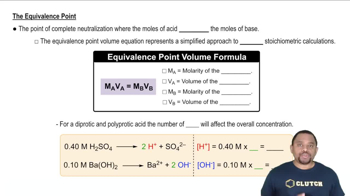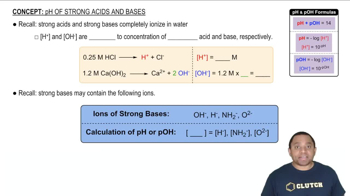Here are the essential concepts you must grasp in order to answer the question correctly.
Titration and Equivalence Point
Titration is a quantitative analytical method used to determine the concentration of a solute in a solution. The equivalence point occurs when the amount of titrant added is stoichiometrically equivalent to the amount of analyte in the solution, meaning that the moles of acid equal the moles of base. In this case, it is crucial to calculate the volume of NaOH needed to reach this point based on the concentrations and volumes of the solutions involved.
Recommended video:
Equivalence Point in Titration
pH and Acid-Base Chemistry
pH is a measure of the acidity or basicity of a solution, defined as the negative logarithm of the hydrogen ion concentration. In acid-base titrations, the pH changes significantly as the titrant is added, especially around the equivalence point. Understanding how the pH behaves in relation to the strength of the acid and base involved is essential for predicting whether the pH at the equivalence point will be greater than, equal to, or less than 7.
Recommended video:
pH of Strong Acids and Bases
Buffer Solutions and Halfway Point
At the halfway point to the equivalence point in a titration of a weak acid with a strong base, the concentrations of the weak acid (HA) and its conjugate base (A-) are equal. This creates a buffer solution, which resists changes in pH. The pH at this point can be calculated using the Henderson-Hasselbalch equation, which relates the pH to the pKa of the weak acid and the ratio of the concentrations of the acid and its conjugate base.
Recommended video:




